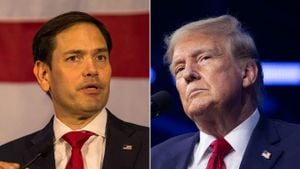Donald Trump’s return to the White House marks significant changes and challenges, not just for American politics but also for how the media will engage with his administration this time around. After defeating Vice President Kamala Harris on November 5, 2024, Trump became only the second president to serve nonconsecutive terms. He’s already assembling his team for this new chapter, with key cabinet nominations rolling out rapidly.
During his address on Thursday, Trump lauded his new cabinet members, including Susie Wiles as chief of staff, Mike Waltz from Florida as national security adviser, and Tom Homan, who is appointed as the “border czar.” Other significant names nominated for key roles are Robert F. Kennedy Jr. for Health and Human Services secretary and Matt Gaetz for attorney general. Trump’s method of bringing back familiar faces along with staunch allies reflects his approach from his previous term.
With Biden and Trump having what was described as a 'substantive meeting' at the White House following the election, discussions centered around national security and domestic policy issues, as well as guidance on government funding and disaster assistance priorities. White House Press Secretary Karine Jean-Pierre emphasized the commitment to maintaining orderly and peaceful transitions of power, with Biden reiteratively stating the importance of stability during this transition period.
One area of intense focus will be Trump’s choice for treasury secretary. Speculations suggest Howard Lutnick and Scott Bessent as leading contenders for the role, but uncertainty remains whether either will secure the position. The choice could hinge on how Trump perceives their strategies aligning with his administration's financial priorities.
The media’s posture toward President Trump is also under scrutiny as he returns to power. After Trump's first term, which was marked by frequent media clashes, outlets are bracing for how to approach this next administration. Many journalists, who previously pledged to avoid covering Trump extensively due to the stress and challenges it posed, are now reconsidering their strategies. Some political reporters are already expressing concern about the toll the reporting will take on their resources and time.
A significant part of Trump's media strategy throughout his first presidency was the tight-knit relationship between his administration and right-wing outlets, predominantly Fox News. This close alliance facilitated Trump’s communication and policy decisions, with influential figures from media now stepping directly back onto the political stage. Tom Homan, known for his controversial role as the acting director of Immigration and Customs Enforcement earlier, is set to transition from contributor on Fox to his new task overseeing immigration policies as part of the incoming administration.
Although the media environment has evolved since Trump’s initial ascension to the presidency, the central question remains: how will journalists balance the demands of covering the White House with ensuring sufficient scrutiny and accountability? Many involved are already debating their strategies for this new chapter, with some emphasizing the need to produce thorough investigative pieces rather than reactive news cycles filled with potentially superficial announcements.
Concerns about Trump’s leadership style and its repercussions are not just confined to Washington D.C. The media will wrestle with whether to adopt different practices when dealing with the White House, especially as Trump’s approach can often flout conventional norms. The fear among newsrooms is how to manage the onslaught of statements and tweets, which often create distractions from more pressing issues the administration may face.
These concerns are paralleled by fears over how institutional changes within the press could manifest under Trump’s aegis. Reporters worry about the past pattern of antagonistic relationships, particularly if Trump’s team chooses to actively ignore certain outlets. The tensions are already evident with lower-tier media struggling to maintain relevance against the highly established and influential voices within right-wing circles.
Trump’s new transition team is already cementing relationships with less traditional platforms and less conventional news outlets, spurred by the exponentially changing dynamics of media consumption since his first term. This shift raises questions about how effectively Trump can balance appealing to more mainstream outlets, which will still provide coverage, and the alternative platforms he favors. There may be greater support for independent media initiatives, and how voters consume news is also likely to influence this during his second term.
On Capitol Hill, as Trump selects advisers and nominees, he positions himself against the backdrop of polarized party politics, seeking to unite the GOP behind his agenda once more. Loyalty among party members and allies is expected as he moves forward with legislative priorities. The urgency of these preferences from various sectors of the party could dictate how smoothly his nominees are confirmed.
Meanwhile, as Washington adjusts to Trump’s return, citizens are gearing up for the effects this will have on the broader national narrative. Experts and political operatives highlight the potential ramifications, both domestically and globally, of policies Trump looks to push through. Observers will need to remain vigilant about how Trump applies lessons learned during his previous presidency as he faces significant external and internal pressures.
Post-midterm elections, Trump’s recount of the electoral battle is being framed within the larger narrative of American exceptionalism — emphasizing his unprecedented electoral comeback, which he and his supporters celebrate fervently. This approach has ripple effects on both the Republican base and wider voter interest, shaping public discourse about governance and accountability.
Overall, as Trump steps back onto the political stage, media outlets worldwide may re-evaluate their methods of covering the presidency. The cyclical nature of politics and media scrutiny raises significant questions about the future of journalism and power within the nation. How journalists and news organizations decide to tackle the unpredictable era of Trump's leadership will have long-lasting consequences for their credibility and the relationship between politicians and the press.



